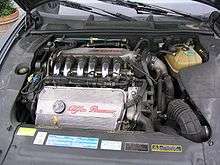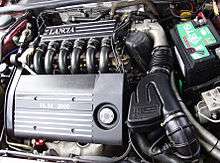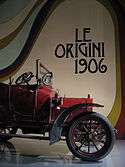Alfa Romeo V6 engine
The Alfa Romeo V6 engine (also called the Busso V6) was a 60° V6 engine made by Alfa Romeo from 1979 to 2005. It was developed in the early 1970s by Giuseppe Busso, and used on the Alfa 6 with a displacement of 2.5 L (2,492 cc) and a SOHC 12-valve cylinder head. Later versions ranged from 1,997 to 3,195 cc (1.997 to 3.195 L) and had DOHC 24-valve valvetrains. The original design had short pushrods for the exhaust valves in a design similar to earlier Lancia Fulvia engines. The first DOHC version was in the 1993 Alfa Romeo 164, with an aluminium alloy engine block and head with sodium filled exhaust valves.
| Alfa Romeo V6 engine | |
|---|---|
 Alfa Romeo 3.0 V6 24V | |
| Overview | |
| Manufacturer | Alfa Romeo (1979-1986) Alfa Lancia Industriale (1987-1991) Fiat Auto (1991-2005) |
| Designer | Giuseppe Busso |
| Also called | Alfa Romeo V6 Busso |
| Production | 1979–2005 |
| Layout | |
| Configuration | 60° V6 |
| Displacement | 2.0 L; 121.8 cu in (1,996 cc) 2.5 L; 152.1 cu in (2,492 cc) 2.8 L; 169.9 cu in (2,784 cc) 2.9 L; 179.0 cu in (2,934 cc) 3.0 L; 180.6 cu in (2,959 cc) 3.2 L; 194.0 cu in (3,179 cc) |
| Cylinder bore | 80 mm (3.15 in) 88 mm (3.46 in) 93 mm (3.66 in) |
| Piston stroke | 66.2 mm (2.61 in) 68.3 mm (2.69 in) 72 mm (2.83 in) 72.6 mm (2.86 in) 78 mm (3.07 in) |
| Block material | Aluminium |
| Head material | Aluminium |
| Valvetrain | SOHC/DOHC 60° 2/4 valves x cylinder, respectively |
| Compression ratio | 8.0:1 – 10.5:1 |
| Combustion | |
| Turbocharger | Mitsubishi TD 05H (164)[1] Garrett T25 (GTV,166)[2][3] |
| Fuel system | 6 Dell'Orto carburetors Fuel injection |
| Management | Bosch L-Jetronic and Motronic |
| Fuel type | Petrol |
| Oil system | Wet sump |
| Cooling system | Water-cooled |
| Output | |
| Power output | 97–184 kW (132–250 PS) |
| Specific power | 66.1 PS (48.6 kW; 65.2 hp)/L-78.6 PS (57.8 kW; 77.5 hp)/L n/a 105.2 PS (77.4 kW; 103.8 hp)/L turbo |
| Torque output | 178–300 N⋅m (131–221 lb⋅ft) |
| Dimensions | |
| Dry weight | 2.5 V6 135 kg (298 lb) (without ancillaries)[4] 375 lb (170 kg) Alfa Romeo SOHC V6[5] |
| Chronology | |
| Predecessor | Alfa Romeo straight-6 |
| Successor | JTS engine |

The Alfa Romeo V6 has been used in kit cars like the Ultima GTR, Hawk HF Series, and DAX,[6][7][8] as well as the Gillet Vertigo sports car.[9] In August 2011 EVO magazine wrote that "the original Alfa Romeo V6 was the most glorious-sounding six-cylinder road engine ever,"[10] while the British Classic & Sports Car magazine described it as "the best sounding engine this side of a Maserati V8." The Alfa Romeo V6 engine has also been used in ice resurfacer made by engo Ltd. in Italy.[11]
12V, two valve
2.0
A 2.0 L; 121.8 cu in (1,996 cc) version was introduced in 1983. Both carburetted 136 PS (100 kW; 134 hp) and fuel-injected 132 PS (97 kW; 130 hp) versions were available from the start.[12]
Applications:
- 1983–1986 Alfa Romeo Alfa 6 2.0 V6
- 1984–1987 Alfa Romeo 90 2.0 V6
2.0 Turbo
A 2.0 L; 121.8 cu in (1,996 cc) turbocharged version, derived from the 3.0 L 12v, first with total digital management, was introduced in 1991 in the Alfa Romeo 164 with 210 PS (154 kW; 207 hp).[13] The engine has a bore and stroke of 80 mm × 66.2 mm (3.15 in × 2.61 in).
Applications:
- 1991–1992 Alfa Romeo 164 V6 Turbo
- 1992–1997 Alfa Romeo 164 Super V6 TB
- 1994–2000 Alfa Romeo GTV 2.0 V6 TB
- 1998–2000 Alfa Romeo Spider 2.0 V6 TB
- 1996–2000 Alfa Romeo 166 Super V6 TB
2.5

The original engine displaced 2.5 L; 152.1 cu in (2,492 cc) and produced 158 PS (116 kW; 156 hp).[12] It was a 2-valve-per-cylinder design with a single belt-driven camshaft per cylinder bank and six carburettors. The engine has a bore and stroke of 88 mm × 68.3 mm (3.46 in × 2.69 in).
The Bosch L-Jetronic fuel injection was added for the 1983 Alfa 6, which produced the same 158 PS (116 kW; 156 hp).[12] The 2-valve engine ended its life in the Alfa 155, where there were two series for this engine, the 2.5 L; 152.1 cu in (2,492 cc) developing 166 PS (122 kW; 164 hp). Differences between them were small and only on torque and power delivery producing exactly the same horsepower.
Applications:
- 1979–1986 Alfa Romeo Alfa 6
- 1980–1986 Alfa Romeo GTV6 (Alfa Romeo Alfetta GTV6 2.5)
- 1984–1987 Alfa Romeo 90
- 1985–1991 Alfa Romeo 75/Milano
- 1992–1997 Alfa Romeo 155
- 1985–1996 Fiat Croma
- 1987–1989 Rayton Fissore Magnum V6[14]
- 1982 AC 3000ME MkII Prototype[15]
2.8 Gleich
In 1982, the German Alfa Romeo dealer and tuner Gleich offered a 2.8 conversion of the GTV6 2.5 engine. Dieter Gleich was sure that engine displacement enlargement is still the best and, for the life of the engine, the healthiest way of tuning. The engine capacity was increased to nearly 2.8 liters by using new bushings and custom-built forged Mahle pistons while the compression ratio was raised from 9.5 to 10.5:1. The 2.5 liter was rebored to 93 mm (3.66 in). Total displacement was 2,783.7 cc (2.8 L). Power produced were 191 PS (140 kW; 188 hp) at 6,300 rpm and torque 24.6 kg⋅m (241 N⋅m; 178 lbf⋅ft) at 4200 rpm.[16]
The magazine "Sport driver" tested a 2.8 Gleich powered GTV6 in June 1982:
"After engaging the first gear and a somewhat careless step on the gas pedal you get a touched feel to the epiphany GTV6 shot, accompanied by the typical Alfa Romeo exhaust sound. It was a pleasure. The fact was the sprint from 0 to 100 km/h (62 mph) is not further under the seven-second limited by a tricky-to-be-shifted five-speed gearbox. The really vehement propulsion waned only when the speedometer 230 km/h (143 mph) mark has left behind. Another eye-opening experience awaits when you realize that the lightning speed to 7000 rpm rotating in any gear pinion even in fifth gear still from 1500 rpm is completely smooth."
Applications:
- 1982 Alfa Romeo Alfetta GTV6 2.8 Gleich
3.0 SA (Autodelta)
The original 2.5 engine as used in the Alfa 6 was bored and stroked by Autodelta, the former Alfa Romeo racing department to match the racing rules for South African and Australian championships. Bore was increased from 88 mm (3.46 in) to 93 mm (3.66 in) and a new crankshaft stroked to 72 mm (2.83 in). The total displacement was 2,939.5 cc (2.9 L) and it's a totally different engine from the later 2,959 cc (3.0 L) that powered the 75/Milano models. It was, too, a 2-valve-per-cylinder design with a single belt-driven camshaft per cylinder bank and six carburettors. Special camshafts and carbs were used giving a power figure of 176.4 PS (130 kW; 174 hp) at 5800 rpm. Torque was 222 N⋅m (164 lb⋅ft) at 4300 rpm, while compression ratio was 9:1.
Only 174 complete GTV6 3.0 SA cars were produced in 1984 plus 68 more in 1985. the last ones were fitted with EFI.
The 3.0 GTV6 was sold in South Africa in 1983-1985, predating the release of the 3.0 L displacement to the rest of the world.[17] This engine was an Autodelta hand made conversion based on Alfa Sei 2.5 carburated engines enlarged to bore and stroke of 93 mm × 72 mm (3.7 in × 2.8 in).[17][18]
Applications:
- 1984–1985 Alfa Romeo Alfetta GTV6 3.0 SA
3.0
Pulled by the racing success of the 3.0 SA engine and looking for more power to boost 75/Milano sales in countries like USA, Alfa Romeo introduced a production version of the 3.0 engine. Bore was 93 mm (3.66 in), as the 3.0 SA, but stroke was increased to 72.6 mm (2.86 in). The total displacement was 2,959 cc (3.0 L). As the previous engines, it was a 2-valve-per-cylinder design with a single belt-driven camshaft per cylinder bank. The main difference with the racing 3.0 SA was the use of modern L-Jetronic fuel injection system by Bosch. Power figures vary from 188 PS (138 kW; 185 hp) to 192 PS (141 kW; 189 hp) at 5800 rpm, with compression ratio 9:1.
This engine was modified for transverse placement in the 164 and fitted with a high-performance camshaft and low-restriction exhaust, producing 192 PS (141 kW; 189 hp) in standard form, 184 PS (135 kW; 181 hp) when a catalyzer was added in 1991, with the Cloverleaf version producing 200 PS (147 kW; 197 hp).
The same engine was fitted to the SZ and RZ - ES30 Zagato, but even more finely tuned with wilder cams and high compression pistons to a further 210 PS (154 kW; 207 hp).[19]
Applications:
- 1987–1991 Alfa Romeo 75/Milano
- 1988–1997 Alfa Romeo 164
- 1989–1991 Alfa Romeo SZ
- 1992–1994 Alfa Romeo RZ
- 1992–1994 Lancia Thema
- 1993–2000 Alfa Romeo Spider
24V, four valve
2.5 24V
A four-valve version was introduced in 1997 with the Alfa Romeo 156. The engine now produced 190 PS (140 kW; 187 hp).[20] In 2001, the V6 was uprated to 192 PS (141 kW; 189 hp).[21] The 166 used a slightly detuned version to make more low rev torque. This engine version was awarded as the International Engine of the Year in 2000.[20] The engine has a bore and stroke of 88 mm × 68.3 mm (3.46 in × 2.69 in), the same as the two-valve.
Applications:
- 1996[22]–2005 Alfa Romeo 156
- 1996[22]–2007 Alfa Romeo 166
3.0 24V


The engine was upgraded to dual overhead cams and four valves per cylinder in 1993. Due to this and other refinements, this engine produced 211 PS (155 kW; 208 hp) for the regular 1993 Alfa Romeo 164, with 230 PS (169 kW; 227 hp) and 276 N⋅m (204 lbf⋅ft) in the 164 QV with its engine producing 232 PS (171 kW; 229 hp) on the Q4 model which in its final production run in 1996, it got reduced to 228 PS (168 kW; 225 hp) but with increased torque.[23] The final run of 3.0 V6 engines in the GTV, Spider and 166 range, produced 218–220 PS (160–162 kW; 215–217 hp)[23] in the Euro 3-compliant version. The engine has a bore and stroke of 93 mm × 72.6 mm (3.66 in × 2.86 in), the same as the two-valve.
Applications:
- 1991 Alfa Romeo Proteo concept car
- 1993–1997 Alfa Romeo 164
- 1994–2000 Lancia Kappa
- 1996–2003 Alfa Romeo GTV
- 2000–2003 Alfa Romeo Spider
- 1996–2007 Alfa Romeo 166
- 2001–2008 Lancia Thesis
- 1998–present Gillet Vertigo (Vertigo used also 3.6 L version)
3.2 24V

In 2002 Alfa Romeo introduced the 156 GTA with a 3.2 L; 194.0 cu in (3,179 cc) version of the V6 with 250 PS (184 kW; 247 hp) and 300 N⋅m (221 lbf⋅ft) of torque.[21] Later this engine was also used in the Alfa Romeo 166, GTV, Spider and Alfa Romeo GT[24] in a slightly detuned form 240 PS (177 kW; 237 hp).[25] The engine has a bore and stroke 93 mm × 78 mm (3.66 in × 3.07 in).[26] In Lancia this engine produced 230 PS (169 kW; 227 hp).[27]
Applications:
- 2002–2005 Alfa Romeo 156 GTA
- 2002–2005 Alfa Romeo 147 GTA
- 2002–2004 Alfa Romeo GTV
- 2002–2004 Alfa Romeo Spider
- 2003–2007 Alfa Romeo 166
- 2003–2010 Alfa Romeo GT
- 2003–2009 Lancia Thesis
Production end
The V6 production ended in 2005 at Alfa Romeo Arese Plant;[28] a stock of five thousand were built, to be used in Lancia Thesis, Alfa 166 and Alfa GT models.[29] The engine was replaced in the 159 and Brera by a new 3.2 L V6 unit combining a General Motors-designed engine block with Alfa Romeo cylinder heads and induction. British automotive engineering company Cosworth was keen to buy assembly lines of the Alfa Romeo V6 engine, but the Italian company did not want to sell it.[30] The last version of 3.2 L engine was Euro4 compliant, so it would have been possible to produce it a couple of years more.[31] The engine's designer Giuseppe Busso died within couple of days after the last engine was produced in Arese.[32]
Since 2015, Fiat Powertrain manufactures the all-new, Ferrari-derived 90° V6 Biturbo engine for the Giulia Quadrifoglio and Stelvio Quadrifoglio.
Notes
- "1991 Alfa Romeo 164 V6 Turbo". carfolio.com/. Retrieved 2009-06-25.
- "1997 Alfa Romeo GTV 2.0 Turbo". www.carfolio. Retrieved 2009-06-25.
- "1998 Alfa Romeo 166 2.0 V6 Turbo". carfolio.com. Retrieved 2009-06-25.
- EPER (version 5.8.0) parts catalogue
- Complete Handbook of Automotive Power Trains, Jan Norbye, 1981
- "Last run wins King of the Mountain". iol.co.za. 2006. Retrieved 2012-06-10.
- "Hawk HF2000/HF3000 Series". hawkcars.co.uk. Retrieved 2009-04-05.
- "DAX Rush Specifications". daxbenelux.com. Archived from the original on 2009-02-27. Retrieved 2009-04-05.
- "Gillett Vertigo Streiff: A body to match its Alfa Romeo heart". autoblog.com. Retrieved 2009-04-05.
- EVO Magazine August 2011 page 77
- ICE PROFI: Engo 270 SX | ICE PROFI, accessdate: 26. October 2019
- ELABORARE: Motore Alfa Romeo V6 - ELABORARE, accessdate: 14. September 2018
- Boitier Rouge: Alfa Romeo 164 : la meilleure des « Tipo 4 » ? | Boitier Rouge, accessdate: 14. September 2018
- "Rayton Fissore Magnum V6 (1987–1989)". 4rouesmotrices.com (in French). Retrieved 2010-05-09.
- This AC 3000 ME MkII Prototype Is The British Lancia Stratos You Never Knew You Wanted • Petrolicious: This AC 3000 ME MkII Prototype Is The British Lancia Stratos You Never Knew You Wanted • Petrolicious, accessdate: 26. January 2020
- Classic Cars: Alfa Romeo GTV6 2.8 specificaties en info - Classic Cars, accessdate: 14. September 2018
- CAR magazine: CLASSIC BUY: Alfa Romeo GTV6 (1982-1985) - CAR magazine, accessdate: 14. September 2018
- topCar magazine online: Alfa 3.0 GTV6 | topCar magazine online, accessdate: 14. September 2018
- Fast Classics: Alfa Romeo S.Z. | Fast Classics, accessdate: 26. October 2019
- "Technical Specifications 156". alfisti.ru. Archived from the original on 10 March 2008. Retrieved 2008-01-28.
- Fiat Chrysler Automobiles EMEA Press: New Alfa 156 and Alfa 156 GTA - Press Releases - Fiat Chrysler Automobiles EMEA Press, accessdate: 14. September 2018
- "Alfa 147 156 166 GT Production Dates". bozhdynsky.com. Retrieved 2 December 2015.
- Quattroruote.it: Listino ALFA ROMEO 164 (1987-1998) - prezzi, caratteristiche tecniche e accessori - Quattroruote.it, accessdate: 14. September 2018
- "2003 Alfa Romeo GT 3.2 V6". carfolio.com. February 28, 2013. Retrieved July 27, 2018.
- Fiche technique Alfa Romeo 166 3.2 V6 240 BLACK LINE 2007: Fiche technique Alfa Romeo 166 3.2 V6 240 BLACK LINE 2007, accessdate: 14. September 2018
- "Alfa Romeo 147 GTA". www.italiaspeed.com. Retrieved 2008-01-28.
- Fiat Chrysler Automobiles EMEA Press: NEW ENGINES FOR THE LANCIA THESIS - Press Releases - Fiat Chrysler Automobiles EMEA Press, accessdate: 14. September 2018
- "News 25.02.2005". italiaspeed.com. Retrieved 2008-01-07.
- "Ad Arese in via di smantellamento la linea di produzione del "6 cilindri"". www2.rdbcub.it (in Italian). Archived from the original on 2013-05-28. Retrieved 2009-05-01.
- "LA COSWORTH AD ARESE". archivio.lastampa.it (in Italian). Archived from the original on 2011-07-22. Retrieved 2009-05-01.
- "Alfa 147 GTA". alfaromeo.co.nz. Archived from the original on 2010-05-25. Retrieved 2009-05-01.
- AutoEdizione.com: Alfisti commemorate Giuseppe Busso in Arese | AutoEdizione.com Archived 2018-10-15 at the Wayback Machine, accessdate: 14. September 2018
Further reading
- The Alfa Romeo V6 Engine High-Performance Manual, Jim Kartalamakis, Veloce Publishing, ISBN 978-1-84584-021-1.
